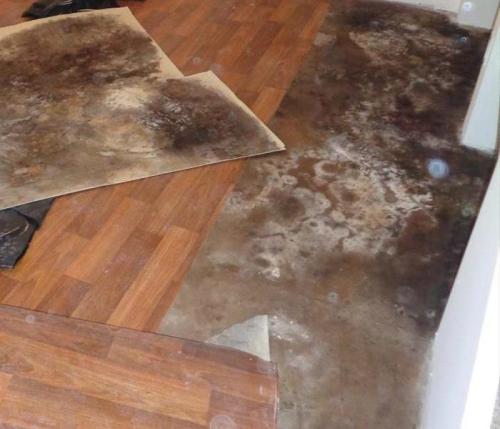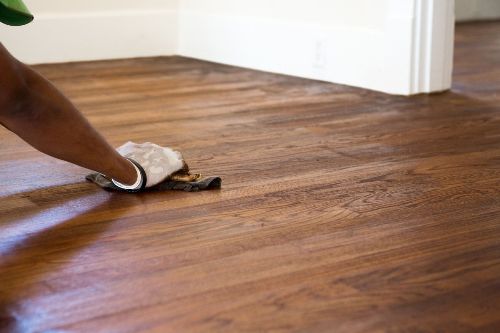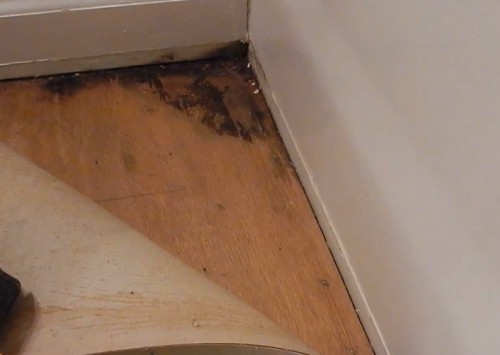What is the biggest problem you come into while cleaning your home? Milk spreading? Food residue? These things are quite easy to handle, but mold under laminate flooring will give you a headache. If you find a dark spot on the floors, then you have to boost up your mind for a vigorous battle with resolving his stubborn mold.
Of course, numerous tips you search on the Internet may put you into a dilemma. That’s why I have written this detailed article to help you tackle this issue depending on my own precious experience. Scroll down to figure out!

Table of Contents
How To Get Rid Of Mold Under Laminate Flooring
The process of getting rid of mold under laminate flooring is a long period that needs your patience. Rest assured that I will show you the quickest and most simple way. Let’s get started.
1. Keep The Laminate Floor Dry And Clean
You must understand that damp floors create a big chance of mold development. It breeds and turns into an uncontrollable colony in favorable environments. That’s why you should keep your laminate floor dry and clean first.
If necessary, leave your shoes out or wear new and clean shoes while going to the mold-contaminated room to prevent any additional spore or moisture.
2. Remove The Uncontaminated Furnishings
You are quite lucky if the black mold only takes up a small space in your home. And do not let it contaminate everything on the floor. It will be best if you bring all the uncontaminated furnishing on your laminate floor to the mold-free areas. Then, put them under sunlight to eliminate any mold spores that are likely to flourish. Precaution will always be our priority.
How to treat mold-contaminated furnishings? I am afraid that you cannot reuse these things no matter how perfectly you deal with mold spores. It cannot disappear completely, so you can only seal them in a trash bag and throw them away.
3. Seal The Molded Room
Remember that handling rooms with molded laminate floors will take time. That’s why you should cut your cleaning time down by sealing the molded room to prevent the spreading to other rooms in your house.
I recommend hanging plastic sheets and securing them with duct tape or pins to seal all the windows and doors.
However, you had better open one window and turn on a fan for better ventilation. Of course, the fan must turn in the opposite direction against the moldy patches, or else you will make the mold spores flourish.
4. Remove The Laminate Flooring
Now, let’s move to the most important part today.

Be careful when you remove the laminate flooring from the molded area. If the mold spores are limited to space, you just need to remove that flooring area and a few surroundings. If you spot any dark patches scattered on the floor, it is better to remove the entire flooring.
The optimal solution here is to remove each section by section from the corner of the laminate flooring. Everything comes to ease when the black mold is on the corner. On the contrary, you have to, unfortunately, eliminate almost all the flooring.
5. Discard Contaminated Floorings
Similar to furnishings, almost all contaminated floorings are not reusable. You must bag and seal them immediately after removing them.
In case of luck, you should follow the advice of some professional mold treatment specialists to discard these floorings until you find the mold spores. Then, scrap a few extra so that all the dark patches are gone.
6. Treat With Mold Removal Product
Of course, there is always another way to reuse the floor. Many people favor Borax for its effectiveness in treating mold-contaminated laminate flooring.
To begin with, stir a cup of Borax and one gallon of water and put the combination in a spray bottle. If the contaminated area is quite big, you can utilize a stiff brush or broom to spread the mixer. After spraying the Borax solution, let it sit for up to 15 minutes and wipe the mold away with a cloth or scrubbing brush afterward.

Remember to wear eye protection, a filtered respiratory mask, and rubber gloves to keep you safe during the cleaning process.
7. Vacuum The Floor
After doing all the treatment, you need to vacuum those areas to remove any inactive spores left. The HEPA vacuum is the best in this case as it can trap and remove all the dried spores.
Moreover, it keeps the treated space dry from water. It is not good to leave the laminate flooring wet again.
Do not forget to spray a Borax solution over the treated area again to avoid mold growth in the future. You should wait for a few minutes and run the dehumidifier to dry up the combination completely.
Suggestions On Mold Prevention

Black mold is likely to bloom and spread when there are small leaks or plumbing problems anywhere in your home. Therefore, you should always apply some preventative measures to battle it first instead of curing it later. Here are some suggestions you can consult:
- Always fix flooding or leakage immediately when you find out.
- Run a dehumidifier in your home to maintain the moisture level.
- Invest in an air purifier to clean the air and destroy spores well.
- Open the windows or use a fan to keep your home ventilated all the time.
In Conclusion
The article on treating black mold under laminate flooring above is all my experience I have learned, and I am truly happy to share it with all you guys. Black mold is unavoidable in every single home, but it is not extremely difficult to end up. That’s why you can handle it yourself.
I believe that you have gained enough information to make your laminate floor clean and bright again confidently after reading my post. Just follow the order of those steps. Good luck!
Related Post:
- Does Laminate Flooring Need to Acclimate? – Notes When Installing Laminate Flooring
- How To Level Furniture On Uneven Floor Effectively And Easily
- How To Install Baseboard Molding On Uneven Floor
- Yoga Mat Tip: How To Stop Yoga Mat From Sliding On Floor?

